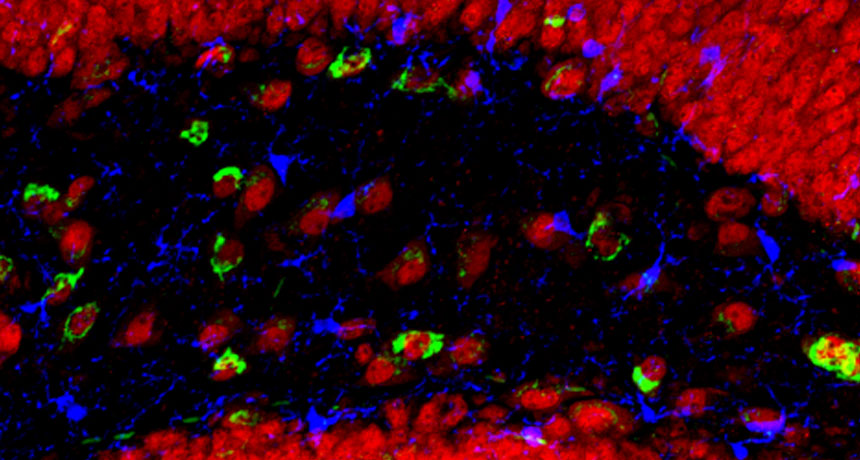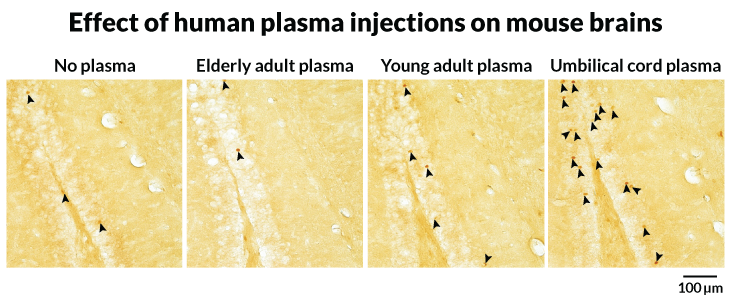Brain gains seen in elderly mice injected with human umbilical cord plasma
Memory protein that declines with aging also identified in mouse study

YOUTHFUL GLOW In the hippocampus of a 1-month-old mouse, some nerve cells (red) produce the protein TIMP2 (green), which declines with age and may help keep the brain young. Blue indicates microglial cells.
J. Castellano et al/Nature 2017
- More than 2 years ago
Plasma taken from human umbilical cords can rejuvenate old mice’s brains and improve their memories, a new study suggests. The results, published online April 19 in Nature, may ultimately help scientists develop ways to stave off aging.
Earlier studies have turned up youthful effects of young mice’s blood on old mice (SN: 12/27/14, p. 21). Human plasma, the new results suggest, confers similar benefits, says study coauthor Joseph Castellano, a neuroscientist at Stanford University. The study also identifies a protein that’s particularly important for the youthful effects, a detail that “adds a nice piece to the puzzle,” Castellano says.
Identifying the exact components responsible for rejuvenating effects is important, says geroscientist Matt Kaeberlein of the University of Washington in Seattle. That knowledge will bring scientists closer to understanding how old tissues can be rejuvenated. And having the precise compounds in hand means that scientists might have an easier time translating therapies to people.
Kaeberlein cautions that the benefits were in mice, not people. Still, he says, “there is good reason to be optimistic that some of these approaches will have similar effects on health span in people.”
Like people, as mice age, brain performance begins to slip. Compared with younger generations, elderly mice perform worse on some tests of learning and memory, taking longer to remember the location of an escape route out of a maze, for instance. Researchers suspect that these deficits come from age-related trouble in the hippocampus, a brain structure important for learning and memory.
Every fourth day for two weeks, Castellano and colleagues injected old mice with human plasma taken from umbilical cords, young adults and elderly adults. The source of plasma infusion changed the behavior of genes in the hippocampus, the researchers found. Elderly mice that had received umbilical cord or young adult plasma showed gene behavior changes that go along with improved hippocampal functioning. And after infusions of human cord plasma, more hippocampus cells churned out a protein called c-Fos, a marker of a busy brain that’s known to decline with age. Elderly mice that received elderly human plasma showed no such changes.
Story continues below image
Brain reset
An elderly mouse that received plasma infusions derived from human umbilical cords (right) had nerve cells in the hippocampus that produced the protein c-Fos (red dots pointed out by black arrows), a marker of nerve cell activity. Some c-Fos protein was seen in elderly brains that received plasma from young adults (middle right). Very little c-Fos was present when the plasma came from elderly people (middle left) or when no plasma was injected (left).

These brain changes came with behavioral improvements, too. Elderly mice that received umbilical cord plasma were quicker to learn and better at remembering the location of an escape hatch in a maze than elderly mice that didn’t receive the plasma. Mice that received injections were also more adept at learning associations between a room and a painful electric shock, and even better at making nests for babies, a skill that usually suffers with age.
Castellano and colleagues searched for the ingredient responsible for the effects by comparing plasma proteins whose abundance changes with age in mice and people. One candidate seemed particularly promising: Levels of a protein called TIMP2 started out high early in life but then dropped with age, in both mice and people.
Infusions of mouse TIMP2 had positive effects on elderly mice, both in their brains and their behavior, the team found. And when researchers removed TIMP2 from young mice, the animals grew worse at remembering new objects.
The study doesn’t explain how TIMP2 might work in the brain, says Gillian Murphy, a molecular cell biologist at the University of Cambridge who studies TIMP proteins and the proteins that TIMPs interact with. “Before any realistic interpretation of these data can be made,” it’s essential to figure out how TIMP2 affects hippocampal cells, she says.
In the meantime, a clinical trial designed to test whether young human plasma can slow the cognitive decline of people with Alzheimer’s disease is under way. Data have been collected and are being analyzed, says study coauthor Tony Wyss-Coray, an Alzheimer’s researcher at Stanford. Wyss-Coray and Castellano have ties to the company Alkahest, which is involved with the clinical trial and therapies to counter aging.






